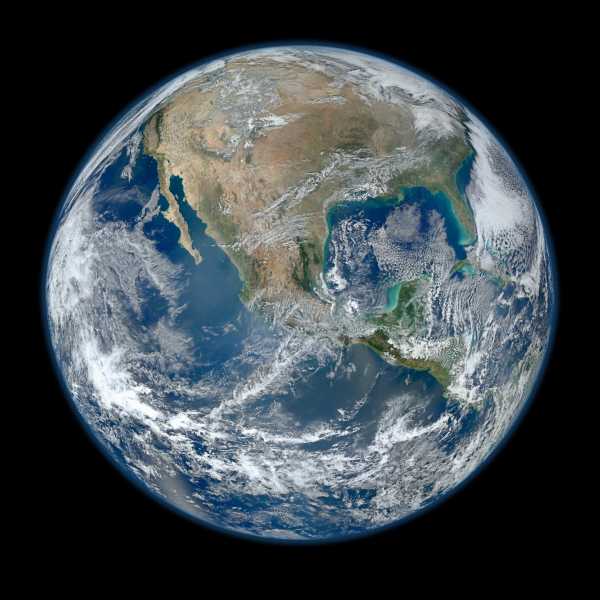
This explainer was updated by Umair Irfan in March 2018, and draws heavily from a card stack written by Brad Plumer in 2015. Brian Resnick contributed the section on the Paris climate accord in 2017.
There is a decisive and growing fissure in America right now as climate change science and federal climate change policy move steadily in opposite directions.
In his first year in office, President Donald Trump has shirked all responsibility on the issue, rejecting or beginning to dismantle President Obama’s signature climate policies: the Paris climate agreement, and the Clean Power Plan, the main domestic policy for limiting greenhouse gas emissions.
Trump has appointed to key positions more than 20 climate change skeptics, including Scott Pruitt and Rick Perry to lead the Environmental Protection Agency and the Department of Energy. And officials at these and other science agencies have been removing the words “climate change” from government websites and press releases.
Meanwhile, the science of climate change is growing ever more robust as researchers zero in on how the greenhouse gases in the atmosphere are radically altering the Earth’s systems and shaping the future.
Atmospheric carbon dioxide concentrations now top 408 parts per million, a threshold the planet hasn’t seen in millions of years. This year, Arctic sea ice is at the lowest extent on record and has been declining faster than it has in 1500 years.
The big questions now are how these changes will reverberate throughout the rest of the world, and what we should do about them. The answers bridge decades of research across geology, economics, and social science, which have been confounded by uncertainty and obscured by jargon. That’s why it can be a bit daunting to join the discussion for the first time, or to revisit the conversation after a hiatus.
To help, we’ve provided some answers to some fundamentals about climate change you may have been afraid to ask.
1) What is global warming?
In short: The world is getting hotter, and humans are responsible.
Yes, the planet’s temperature has changed before, but it’s the rise in average temperature of the Earth’s climate system since the late 19th century, the dawn of the Industrial Revolution, that’s important here. Temperatures over land and ocean have gone up 0.8°-1° Celsius (1.4°-1.8° Fahrenheit), on average, in that span:
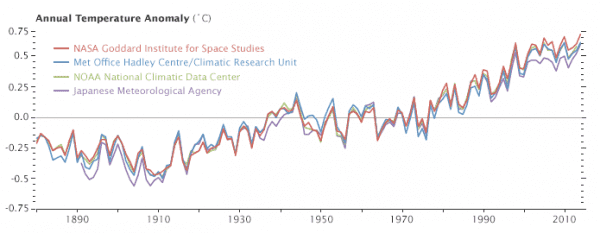

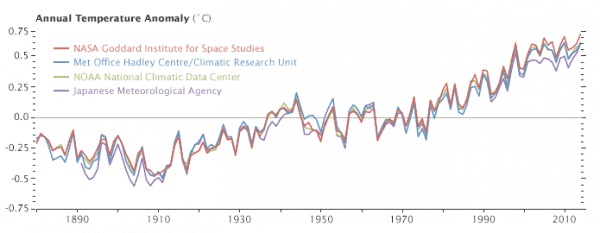
Many people use the term “climate change” to describe this rise in temperatures and the associated effects on the Earth’s climate. (The shift from the term “global warming” to “climate change” was also part of a deliberate messaging effort by a Republican pollster to undermine support for environmental regulations.)
Like detectives solving a murder, climate scientists have found humanity’s fingerprints all over the planet’s warming, with the bulk of the evidence pointing to the extra greenhouse gases humans have put into the atmosphere by burning fossil fuels. Greenhouse gases like carbon dioxide trap heat at the Earth’s surface, preventing that heat from escaping back out into space too quickly. So when we burn coal or oil for energy or cut down forests, thereby adding even more carbon dioxide to the atmosphere, the planet warms up.
Global warming also refers to what scientists think will happen in the future if humans keep adding greenhouse gases to the atmosphere.
Though there is a constant stream of new studies on climate change, the most robust aggregation of the science remains the Intergovernmental Panel on Climate Change’s fifth assessment report from 2013. The IPCC is convened by the United Nations and the report draws on more than 800 expert authors. It projects that temperatures could rise at least 2°C (3.6°F) by the end of the century under many plausible scenarios — and possibly 4°C or more. A more recent study by scientists in the United Kingdom found a narrower range of expected temperatures if atmospheric carbon dioxide doubled, rising between 2.2°C and 3.4°C.
Many experts consider 2°C of warming to be unacceptably high, increasing the risk of deadly heat waves, droughts, flooding, and extinctions. Rising temperatures will drive up global sea levels as the world’s glaciers and ice sheets melt. Further global warming could affect everything from our ability to grow food to the spread of disease.
Avoiding drastic global warming would likely require a complete overhaul of our energy system. Fossil fuels currently provide just over 80 percent of the world’s energy. To zero out emissions this century, we’d have to replace most of that with low-carbon sources like wind, solar, nuclear, geothermal, or carbon capture.
Beyond that, we may have to electrify everything that uses energy and start pulling greenhouse gases straight from the air.
That’s a staggering task, and there are huge technological and political hurdles standing in the way. As such, the world’s nations have been slow to act on global warming — many of the existing targets for curbing greenhouse gas emissions are too weak, yet many countries are falling short of even these modest goals.
2) How do we know global warming is real?
The simplest way is through temperature measurements. Agencies in the United States, Europe, and Japan have independently analyzed historical temperature data and reached the same conclusion: the Earth’s average surface temperature has risen roughly 0.8° Celsius (1.4° Fahrenheit) since the early 20th century.
But that’s not the only clue. Scientists have also noted that glaciers and ice sheets around the world are melting. Satellite observations since the 1970s have shown warming in the lower atmosphere. There’s more heat in the ocean, causing water to expand and sea levels to rise. Plants are flowering earlier in many parts of the world. There’s more humidity in the atmosphere. Here’s a summary from the National Oceanic and Atmospheric Administration:
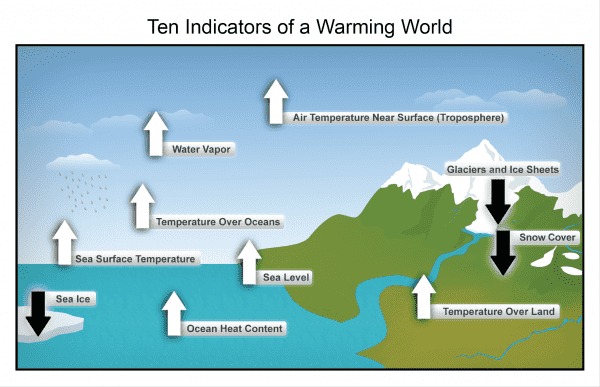

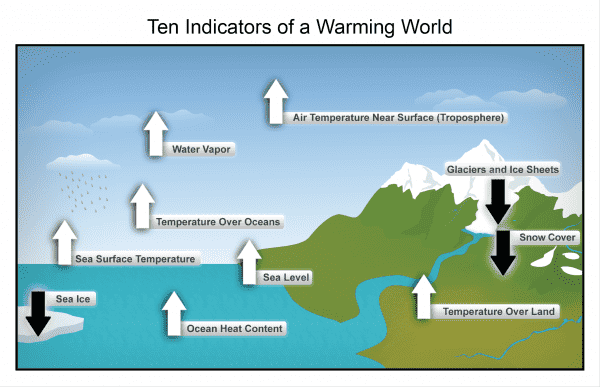
These are all signs that the Earth really is getting warmer — and that it’s not just a glitch in the thermometers. That explains why climate scientists say things like, “Warming in the climate system is unequivocal.” They’re really confident about this one.
3) How do we know humans are causing global warming?
Climate scientists say they are more than 95 percent certain that human influence has been the dominant cause of global warming since 1950. They’re about as sure of this as they are that cigarette smoke causes cancer.
Why are they so confident? In part because they have a good grasp on how greenhouse gases can warm the planet, in part because the theory fits the available evidence, and in part because alternate theories have been ruled out. Let’s break it down in six steps:
1) Scientists have long known that greenhouse gases in the atmosphere — such as carbon dioxide, methane, or water vapor — absorb certain frequencies of infrared radiation and scatter them back toward the Earth. These gases essentially prevent heat from escaping too quickly back into space, trapping that radiation at the surface and keeping the planet warm.
2) Climate scientists also know that concentrations of greenhouse gases in the atmosphere have grown significantly since the Industrial Revolution. Carbon dioxide has risen 45 percent. Methane has risen more than 200 percent. Through some relatively straightforward chemistry and physics, scientists can trace these increases to human activities like burning oil, gas, and coal.
3) So it stands to reason that more greenhouse gases would lead to more heat. And indeed, satellite measurements have shown that less infrared radiation is escaping out into space over time and instead returning to the Earth’s surface. That’s strong evidence that the greenhouse effect is increasing.
4) There are other human fingerprints that suggest increased greenhouse gases are warming the planet. For instance, back in the 1960s, simple climate models predicted that global warming caused by more carbon dioxide would lead to cooling in the upper atmosphere (because the heat is getting trapped at the surface). Later satellite measurements confirmed exactly that. Here are a few other similar predictions that have also been confirmed.
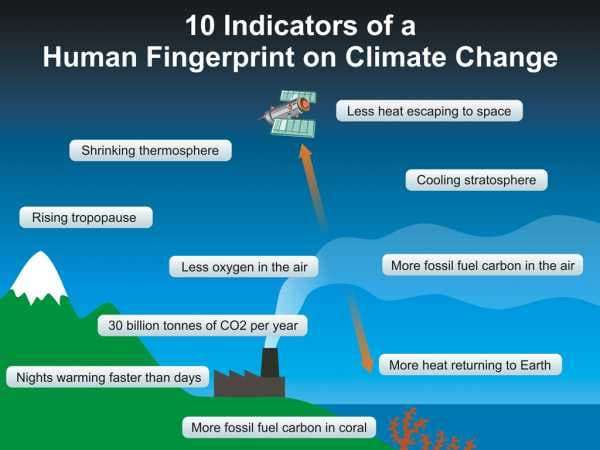

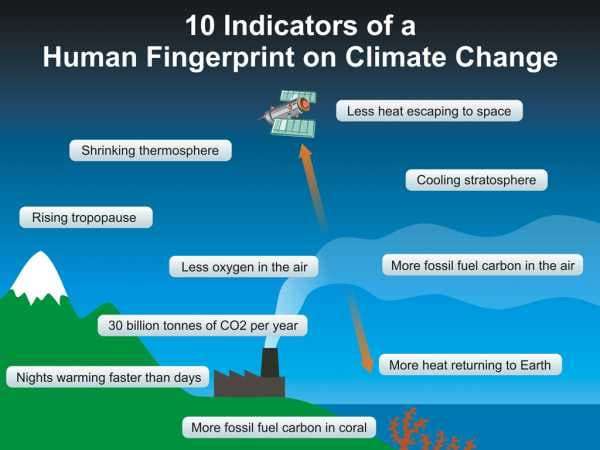
5) Meanwhile, climate scientists have ruled out other explanations for the rise in average temperatures over the past century. To take one example: Solar activity can shift from year to year, affecting the Earth’s climate. But satellite data shows that total solar irradiance has declined slightly in the past 35 years, even as the Earth has warmed.
6) More recent calculations have shown that it’s impossible to explain the temperature rise we’ve seen in the past century without taking the increase in carbon dioxide and other greenhouse gases into account. Natural causes, like the sun or volcanoes, have an influence, but they’re not sufficient by themselves.
Ultimately, the Intergovernmental Panel on Climate Change (IPCC) concluded that most of the warming since 1951 has been due to human activities. The Earth’s climate can certainly fluctuate from year to year due to natural forces (including oscillations in the Pacific Ocean, such as El Niño). But greenhouse gases are driving the larger upward trend in temperatures.
And as the Climate Science Special Report, released by 13 US federal agencies in November 2017, put it, “For the warming over the last century, there is no convincing alternative explanation supported by the extent of the observational evidence.”
More: This chart breaks down all the different factors affecting the Earth’s average temperature. And there’s much more detail in the IPCC’s report, particularly this section and this one.
4) How has global warming affected the world so far?
Here’s a list of ongoing changes that climate scientists have concluded are likely linked to global warming, as detailed by the Intergovernmental Panel on Climate Change (IPCC) here and here.
Higher temperatures: Every continent has warmed substantially since the 1950s. There are more hot days and fewer cold days, on average, and the hot days are hotter.
Heavier storms and floods: The world’s atmosphere can hold more moisture as it warms. As a result, the overall number of heavier storms has increased since the mid-20th century, particularly in North America and Europe (though there’s plenty of regional variation). Scientists reported in December that at least 18 percent of Hurricane Harvey’s record-setting rainfall over Houston in August was due to climate change.
Heat waves: Heat waves have become longer and more frequent around the world over the past 50 years, particularly in Europe, Asia, and Australia.
Shrinking sea ice: The extent of sea ice in the Arctic, always at its maximum in winter, has shrunk since 1979, by 3.3 percent per decade. Summer sea ice has dwindled even more rapidly, by 13.2 percent per decade. Antarctica has seen recent years with record growth in sea ice, but it’s a very different environment than the Arctic, and the losses in the north far exceed any gains at the South Pole, so total global sea ice is on the decline:
Shrinking glaciers and ice sheets: Glaciers around the world have, on average, been losing ice since the 1970s. In some areas, that is reducing the amount of available freshwater. The ice sheet on Greenland, which would raise global sea levels by 25 feet if it all melted, is declining, with some sections experiencing a sudden surge in the melt rate. The Antarctic ice sheet is also getting smaller, but at a much slower rate.
Sea-level rise: Global sea levels rose 9.8 inches (25 centimeters) in the 19th and 20th centuries, after 2,000 years of relatively little change, and the pace is speeding up. Sea-level rise is caused by both the thermal expansion of the oceans — as water warms up, it expands — and the melting of glaciers and ice sheets (but not sea ice).
Food supply: A hotter climate can be both good for crops (it lengthens the growing season, and more carbon dioxide can increase photosynthesis) and bad for crops (excess heat can damage plants). The IPCC found that global warming was currently benefiting crops in some high-latitude areas, but that negative effects are becoming increasingly common worldwide. In areas like California, crop yields are estimated to decline 40 percent by 2050.
Shifting species: Many land and marine species have had to shift their geographic ranges in response to warmer temperatures. So far, several extinctions have been linked to global warming, such as certain frog species in Central America.
Debated impacts
Here are a few other ways the Earth’s climate has been changing — but scientists are still debating whether and how they’re linked to global warming:
Droughts have become more frequent and more intense in some parts of the world — such as the American Southwest, Mediterranean Europe, and West Africa — though it’s hard to identify a clear global trend. In other parts of the world, such as the Midwestern United States and Northwestern Australia, droughts appear to have become less frequent. A recent study shows that, globally, the time between droughts is shrinking and that more areas are affected by drought and taking longer to recover from them.
Hurricanes have clearly become more intense in the North Atlantic Ocean since 1970, the IPCC says. But it’s less clear whether global warming is driving this. 2017 was an exceptionally bad year for Atlantic hurricanes in terms of strength and damage. And while scientists are still uncertain whether they were a fluke or part of a trend, they are warning we should treat it as a baseline year. There doesn’t yet seem to be any clear trajectory for tropical cyclones worldwide.
5) What impacts will global warming have in the future?
It depends on how much the planet actually heats up. The changes associated with 4° Celsius (or 7.2º Fahrenheit) of warming are expected to be more dramatic than the changes associated with 2°C of warming.
Here’s a basic rundown of big impacts we can expect if global warming continues, via the Intergovernmental Panel on Climate Change (here and here).
Hotter temperatures: If emissions keep rising unchecked, then global average surface temperatures will be at least 2ºC higher (3.6ºF) than pre-industrial levels by 2100 — and possibly 3ºC or 4ºC or more.
Higher sea-level rise: The expert consensus is that global sea levels will rise somewhere between 0.2 and 2 meters by the end of the century if global warming continues unchecked (that’s between 0.6 and 6.6 feet). That’s a wide range, reflecting some of the uncertainties scientists have in how ice will melt. In specific regions like the Eastern United States, sea-level rise could be even higher, and around the world, the rate of rise is accelerating.
Heat waves: A hotter planet will mean more frequent and severe heat waves.
Droughts and floods: Across the globe, wet seasons are expected to become wetter, and dry seasons drier. As the IPCC puts it, the world will see “more intense downpours, leading to more floods, yet longer dry periods between rain events, leading to more drought.”
Hurricanes: It’s not yet clear what impact global warming will have on tropical cyclones. The IPCC said it was likely that tropical cyclones would get stronger as the oceans heat up, with faster winds and heavier rainfall. But the overall number of hurricanes in many regions was likely to “either decrease or remain essentially unchanged.”
Heavier storm surges: Higher sea levels will increase the risk of storm surges and flooding when storms do hit.
Agriculture: In many parts of the world, the mix of increased heat and drought is expected to make food production more difficult. The IPCC concluded that global warming of 1°C or more could start hurting crop yields for wheat, corn, and rice by the 2030s, especially in the tropics. (This wouldn’t be uniform, however; some crops may benefit from mild warming, such as winter wheat in the United States.)
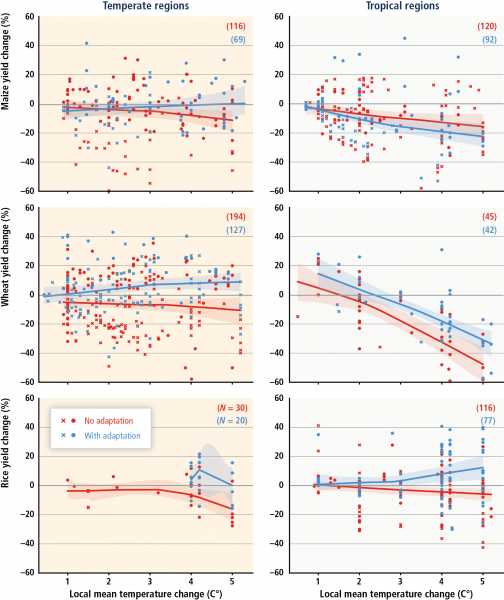

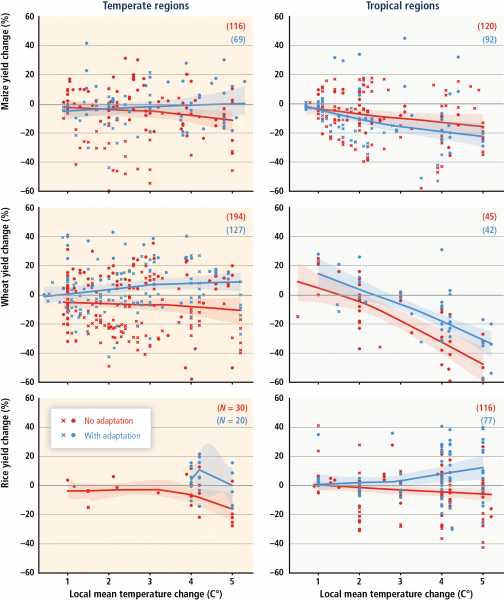
Extinctions: As the world warms, many plant and animal species will need to shift habitats at a rapid rate to maintain their current conditions. Some species will be able to keep up; others likely won’t. The Great Barrier Reef, for instance, may not be able to recover from major recent bleaching events linked to climate change. The National Research Council has estimated that a mass extinction event “could conceivably occur before the year 2100.”
Long-term changes: Most of the projected changes above will occur in the 21st century. But temperatures will keep rising after that if greenhouse gas levels aren’t stabilized. That increases the risk of more drastic longer-term shifts. One example: If West Antarctica’s ice sheet started crumbling, for instance, that could push sea levels up significantly. The National Research Council in 2013 deemed many of these rapid climate surprises unlikely this century, but a real possibility farther into the future.
6) What happens if the world heats up more drastically — say 4°C?
The risks of climate change would rise considerably if temperatures rose 4° Celsius (7.2° Fahrenheit) above preindustrial levels — something that’s possible if greenhouse gas emissions keep rising at their current rate.
The Intergovernmental Panel on Climate Change says 4°C of global warming could lead to “substantial species extinctions,” “large risks to global and regional food security,” and the risk of irreversibly destabilizing Greenland’s massive ice sheet.
One huge concern is food production: A growing number of studies suggest it would become significantly more difficult for the world to grow food with 3°C or 4°C of global warming. Countries like Bangladesh, Egypt, Vietnam, and parts of Africa could see large tracts of farmland turn unusable by rising seas. Scientists are also concerned about crops are crops getting less nutritious due to rising CO2.
And humans could struggle to adapt to these conditions. Many people might think the impacts of 4°C of warming will simply be twice as bad as those of 2°C. But as a 2013 World Bank report argued, that’s not necessarily true. Impacts may interact with each other in unpredictable ways. Current agriculture models, for instance, don’t have a good sense of what will happen to crops if increased heat waves, droughts, new pests and diseases, and other changes all start combining.
“Given that uncertainty remains about the full nature and scale of impacts,” the World Bank report said, “there is also no certainty that adaptation to a 4°C world is possible.” Its conclusion was blunt: “The projected 4°C warming simply must not be allowed to occur.”
7) What do climate models say about the warming that could actually happen in the coming decades?
That depends on your faith in humanity.
Climate models not only depend on complicated physics but the intricacies of human behavior over the entire planet.
Generally, the more greenhouse gases humanity pumps into the atmosphere, the warmer it will get. But scientists aren’t certain how sensitive the global climate system is to increases in greenhouse gases. And just how much we might emit over the coming decades remains an open question, depending on advances in technology and international efforts to cut emissions.
The IPCC groups these scenarios into four categories of atmospheric greenhouse gas concentrations known as Representative Concentration Pathways. They serve as standard benchmarks for evaluating climate models, but they also have some assumptions baked in.
RCP 2.6, also called RCP 3PD, is the scenario with very low greenhouse gas concentrations in the atmosphere. It bets on declining oil use, a population of 9 billion by 2100, increasing energy efficiency, and emissions holding steady until 2020, at which point they’ll decline and even go negative by 2100. This is, to put it mildly, very optimistic.
The next tier up is RCP 4.5, which still banks on ambitious reductions in emissions, but anticipates an inflection point in the emissions rate around 2040. RCP 6 expects emissions to increase 75 percent above today’s levels before peaking and declining around 2060 as the world continues to rely heavily of fossil fuels.
The highest tier, RCP 8.5, is the business as usual scenario, with no policy changes. It expects a global population of 12 billion and triple the rate of carbon dioxide emissions compared to today by 2100.
Here’s how greenhouse gas emissions under each scenario stack up next to each other:
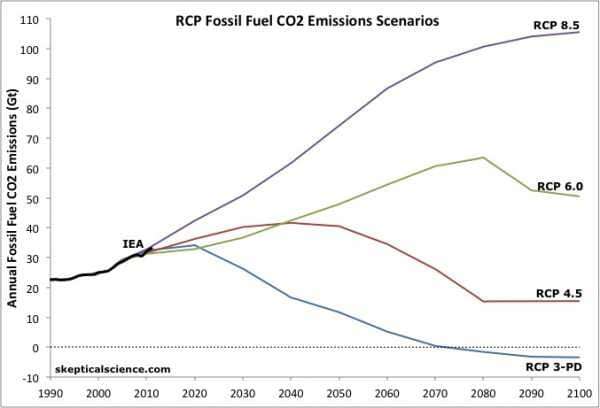

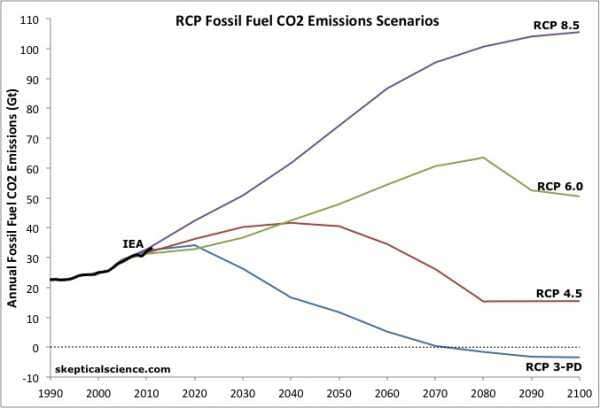
And here’s what that means for global average temperatures, assuming that a doubling of carbon dioxide concentrations in the atmosphere leads to 3°C of warming:
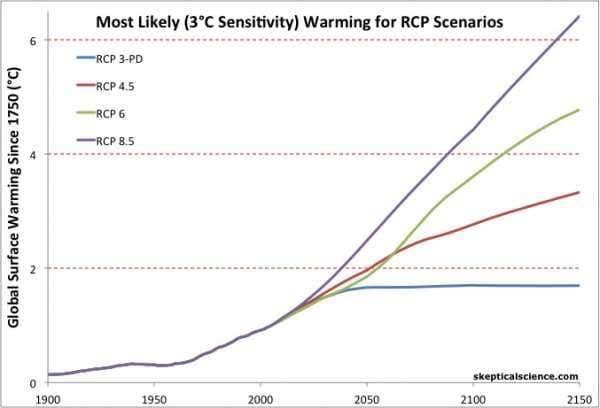

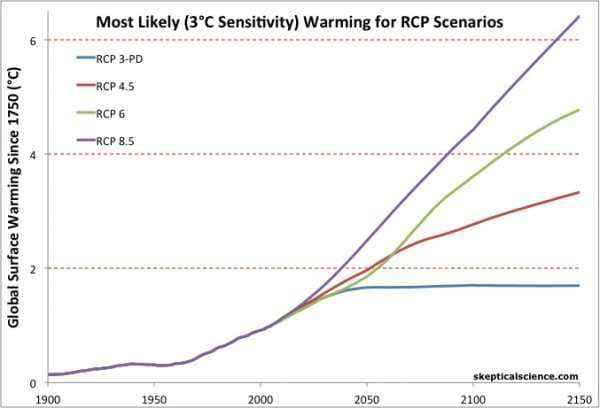
As you can see, only RCP 3PD is the only trajectory that keeps the planet below 2°C of warming. Recall what it would take to keep emissions in line with this pathway and you’ll understand the enormity of the challenge of meeting this goal.
8) How do we stop global warming?
The world’s nations would need to cut their greenhouse gas emissions by a lot. And even that wouldn’t stop all global warming.
For example, let’s say we wanted to limit global warming to below 2°C. To do that, the IPCC has calculated that annual greenhouse gas emissions would need to drop at least 40 to 70 percent by mid-century.
Emissions would then have to keep falling until humans were hardly emitting any extra greenhouse gases by the end of the century. We’d also likely need to remove carbon dioxide from the atmosphere.
Cutting emissions that sharply is a daunting task. Right now, the world gets 87 percent of its primary energy from fossil fuels: oil, gas, and coal. By contrast, just 13 percent of the world’s primary energy is “low carbon”: a little bit of wind and solar power, some nuclear power plants, a bunch of hydroelectric dams. That’s one reason why global emissions keep rising each year.
To stay below 2°C, that would all need to change radically. By 2050, the IPCC notes, the world would need to triple or even quadruple the share of clean energy it uses — and keep scaling it up thereafter. Second, we’d have to get dramatically more efficient at using energy in our homes, buildings, and cars. And stop cutting down forests. And reduce emissions from agriculture and from industrial processes like cement manufacturing.
The IPCC also notes that this task becomes even more difficult the longer we put it off, because carbon dioxide and other greenhouse gases will keep piling up in the atmosphere in the meantime, and the cuts necessary to stay below the 2°C limit become more severe.
9) What are we actually doing to fight climate change?
A global problem requires global action, but with climate change, there is a yawning gap between ambition and action.
The main international effort is the 2015 Paris climate accord, of which the United States is the only country in the world that wants out. The deal was hammered out over weeks of tense negotiations and weighs in at 31 pages. What it does is actually pretty simple.
The backbone is the global target of keeping global average temperatures from rising 2°C (compared to temperatures before the Industrial Revolution) by the end of the century. Beyond 2 degrees, we risk dramatically higher seas, changes in weather patterns, food and water crises, and an overall more hostile world.
Critics have argued that the 2-degree mark is arbitrary, or even too low, to make a difference. But it’s a starting point, a goal that, before Paris, the world was on track to wildly miss.
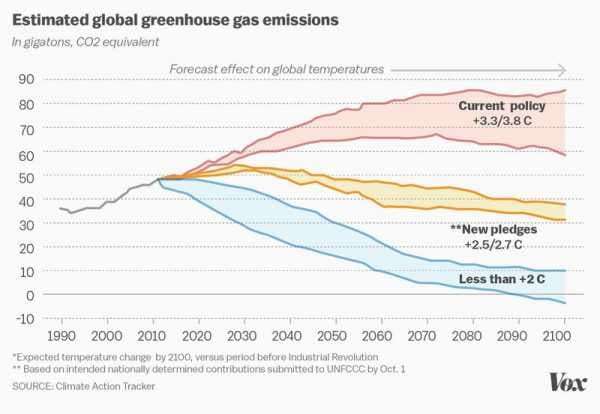

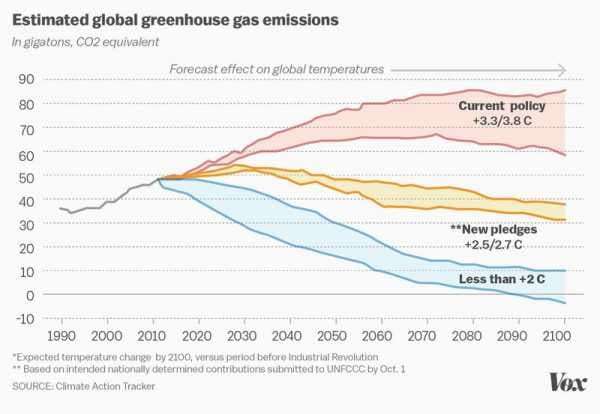
Paris is voluntary
To accomplish this 2-degree goal, the accord states that countries should strive to reach peak emissions “as soon as possible.” (Currently, we’re on track to hit peak emissions around 2030 or later, which will likely be too late.)
But the agreement doesn’t detail exactly how these countries should do that. Instead, it provides a framework for getting momentum going on greenhouse gas reduction, with some oversight and accountability. For the US, the pledge involves 26 to 28 percent reductions by 2025. (Under Trump’s current policies, that goal is impossible.)
There’s also no defined punishment for breaking it. The idea is to create a culture of accountability (and maybe some peer pressure) to get countries to step up their climate game.
In 2020, delegates are supposed to reconvene and provide updates about their emission pledges and report on how they’re becoming more aggressive on accomplishing the 2-degree goal.
However, many countries are already falling behind on their climate change commitments and some, like Germany, are giving up on their near-term targets.
Paris asks richer countries to help out poorer countries
There’s a fundamental inequality when it comes to global emissions. Rich countries have plundered and burned huge amounts of fossil fuels, and gotten rich from them. Poor countries seeking to grow their economies are now being admonished for using the same fuels. Many low-lying poor countries also will be among the first to bear the worst impacts of climate change.
The main vehicle for rectifying this is the Green Climate Fund in which richer countries, like the US, are supposed to send $100 billion a year in aid and financing by 2020 to the poorer countries. The United States’ share was $3 billion, but with President Trump’s decision to withdraw from the Paris accord, this goal is unlikely to be met.
The agreement matters because we absolutely need momentum on this issue
The Paris agreement is largely symbolic, and it will live on even though Trump is aiming to pull the US out. But, as Jim Tankersley wrote for Vox, “the accord will be weakened, and, much more importantly, so will the fragile international coalition” around climate change.
But the Paris accord isn’t the only international climate policy game in town
There are regional international climate efforts like the European Union’s Emissions Trading System. However, the most effective global policy at keeping warming in check to date doesn’t have to do with climate change, at least on the surface.
The 1987 Montreal Protocol, which was convened by countries to halt the destruction of the ozone layer, had a major side effect of averting warming. In fact, it’s been the single most effective effort humanity has undertaken to fight climate change. Since many of the substances that eat away at the ozone layer are potent heat-trappers, limiting emissions of gases like chlorofluorocarbons has an outsized effect.
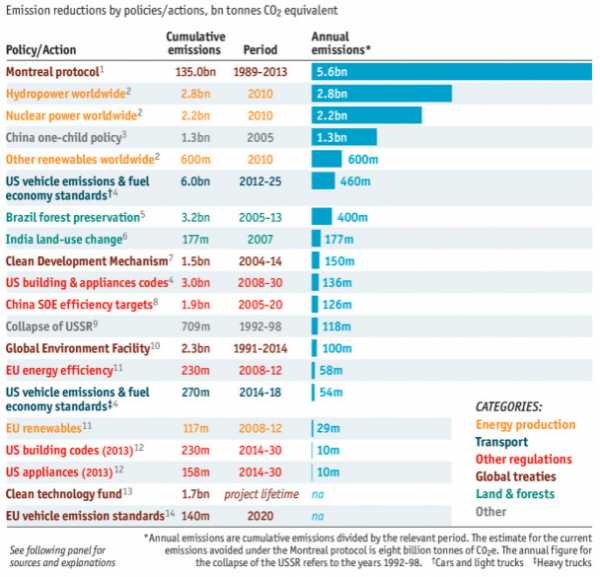

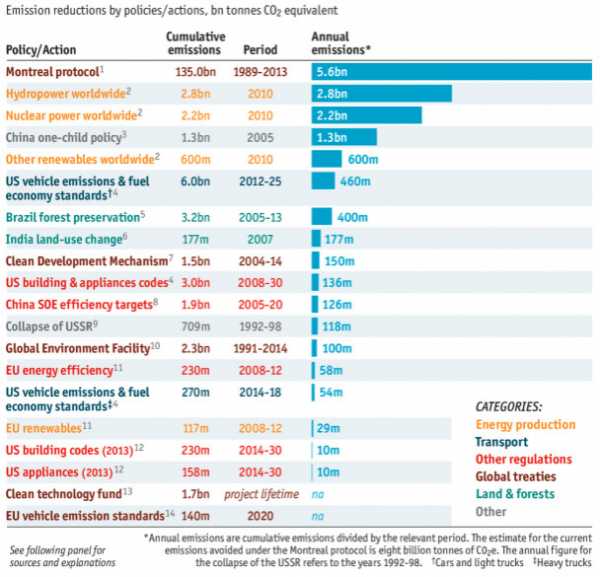
And the Trump administration doesn’t appear as hostile to Montreal as it does to Paris. The White House may send the 2016 Kigali Amendment to the Montreal Protocol to the Senate for ratification, giving the new regulations the force of law. If implemented, the amendment would avert 0.5°C of warming by 2100.
Further reading:
Avoiding catastrophic climate change isn’t impossible yet. Just incredibly hard.
Reckoning with climate change will demand ugly tradeoffs from environmentalists — and everyone else
Show this cartoon to anyone who doubts we need huge action on climate change
It’s time to start talking about “negative” carbon dioxide emissions
A history of the 2°C global warming target
Scientists made a detailed “roadmap” for meeting the Paris climate goals. It’s eye-opening
Sourse: vox.com






